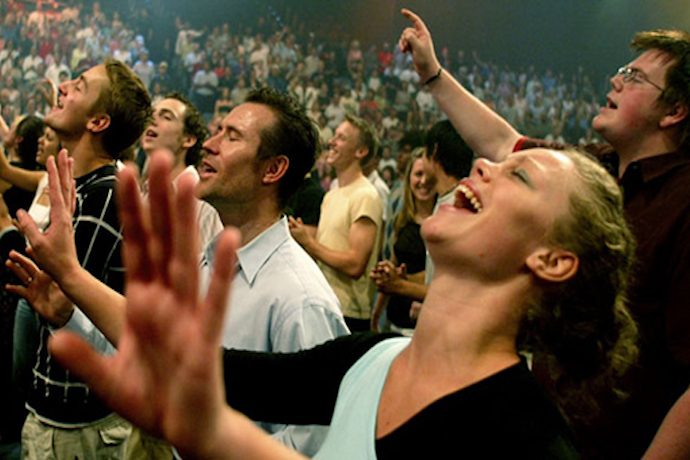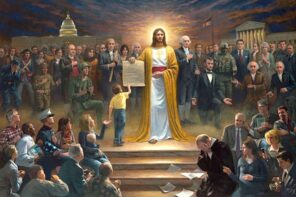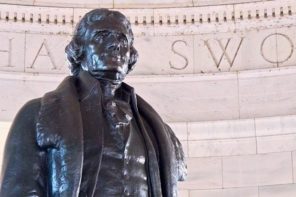Comedian John Crist’s YouTube sketches lampooning Christian subculture have gained notoriety largely due to the repetitive one liners that tap directly into the core of American Christianity writ large. A recent sketch, satirizing what a pastor or worship director at a large church would say in preparation for Easter Sunday, includes laugh lines like:
- “Do we have the right amount of haze in the fog machine?”
- “We are pro-Jesus and pro-Easter Bunny!” and
- “Do we have the rose petals in the visitor parking?”
As well as some more poignant one-liners, like: “We need more diversity on that stage!” and “What about that one minority guy? Can we get him to do announcements?”
Crist’s sketch functions as a reminder of the fact that, as Dr. Martin Luther King once famously remarked, the eleven o’clock hour on Sunday morning is the most segregated hour of American life. Despite all that’s occurred over the past 50 years in the culture more broadly, and all the Christian hand-wringing, American churches have remained largely segregated. And, while many have sought more benign explanations, others have spoken for quite some time, albeit in hushed voices, about the racial gatekeeping that persists in much of white Christian America.
Talk of gatekeeping was largely anecdotal, until now. In a recent study called “‘Race Tests’: Racial Boundary Maintenance in White Evangelical Churches,” published by Sociological Inquiry, researchers Glenn E. Bracey, II and Wendy Leo Moore sought to reveal how evangelical religious organizations, many of which claim to be open, remain so heavily segregated.
Bracey and Moore hypothesize that these ecclesial organizations perform a “race test” on incoming persons of color that manifest as anything from micro-aggressions to outright overtures of racial stereotypes, in effect seeing “whether the people of color are willing to serve the interests of whites in the space, or execute exclusionary race tests to coerce people of color into leaving the space.”
To turn on the TV and watch the telecasts of churches, it’s easy to see that most churches have a super-majority of one race or ethnicity. While many of the church-going population have no problem acknowledging tendencies toward racial segregation in voluntary groups, this new study shows that there is a toxic combination of unintentional and intentional behaviors that are keeping white evangelical churches mostly white.
The researchers introduce the notion that these white evangelical churches have created what they call “white institutional space.”
Simply put, white institutional space is created through a process that begins with whites excluding people of color, either completely or from institutional positions of power, during a formative period in the history of an organization. During this period, whites populate all influential posts within the institution and create institutional logics—norms of operation, organizational structures, curricula, criteria for membership and leadership—which imbed white norms into the fabric of the institution’s structure and culture. Although the norms are white, they are rarely marked as such. Consequently, racially biased institutional norms are wrongly defined as race-neutral, and thus merely characteristic of the institution itself (e.g., “the appropriate way to act in church”), masking inherent institutional racism.
Bracey, who is African American, ventured into seven churches and attempted engagement in numerous ways. In one of the more passive micro-aggressions, on an early visit, a white congregant whom he’d been emailing with, immediately introduced him to a black mother and her apparently biracial child. The lady even slipped, saying “I’ve been praying that God would send a bla—, a man, that could step in and be a father figure to this child.” One of the other examples was a trip to a small group meeting where pictures of Confederate soldiers were proudly displayed and where the homeowner spoke of the “heroism and hardships of his Confederate ancestors.” Bracey left the meeting quickly, faking an emergency.
Each interaction Bracey had with church members seemed to get decidedly worse than the previous one, as if there were a level of intentionality to maintaining white exclusivity. The study delineated between utility-based race tests and exclusionary race tests. The former is where one’s entry is pre-conditioned, based on how the white institutional space expects a person of color to behave; while the latter functions as a bolder macro-aggressive statement, outwardly expressing sentiments of exclusion. One of the macro-aggressive examples occurred during a small group session at a congregant’s house, when one member of the group made a reference to his “China Gun”—because of the “chink chink” sound it makes when being cocked. He then proceeded to point his imaginary gun at a Latino participant and the researcher.
There are some deeper theological and ecclesiastical questions that are triggered by this study, including: how does evangelical Christianity propagate white institutional spaces so well? Most protestants have left behind the iconography that depicted Jesus as a medium-to-small-framed white guy with either blond of brown hair wearing a robe. But, as contemporary churches designed new sanctuary spaces, with massive stages replacing traditional pulpits, the actors on the stage replaced the icons. Effectively, then, “Jesus” was still a medium-to-small-framed white guy with either blond or brown hair. When the representation of holiness—in pastors, lay leaders and worship leaders—is still overwhelmingly white, it will consistently perpetuate white institutional space. The tokenization of persons of color in the worship bands merely adds fuel to the machine of white institutional spaces; that persons of color can only function for minstrel entertainment purposes.
The failure of ecclesiastical white institutional spaces to find ways to bridge the gap across racial and ethnic boundaries draws a direct correlation to the persistent reluctance of white Christians to accept a gospel message from anyone but another white person—usually a male. Recall, then-candidate Barack Obama’s pastor, Rev. Jeremiah Wright, and the numerous denouncements from the Christian right and moderates about how black liberation theology was heretical and separatist in nature. The distinct incapacity to accept another lived reality as it encounters the Gospel of Jesus is the breathing apparatus that gives life to white institutional spaces that are, as Bracey and Moore put it: “normatively white in policy and practice by explicitly accounting for the intersecting mechanisms—structure, culture, ideology, and discourse—that justify and reproduce white privilege, power and accumulation of resources in these institutions.” In other words: white is, and will continue to be, right.
Recently, here on RD, Deborah Jian Lee reported on the ways in which persons of color are pressured to perform to standards of whiteness in evangelical spaces. She writes that “for those staying, they must contend with a dominant white theology shaped in the cauldron of privilege…. It fails to recognize how unfair policies and societal structures harm the economic and social wellbeing of those subject to those systems.” Her article is bookended by the story of a person of color, pastor George Mekhail, who ultimately chose to leave evangelicalism. Unfortunately, that’s the choice that many face: stay and try to fight an uphill battle or leave and let the chips fall where they may.
Not so fast, liberals
As the Bracey/Moore study alludes to, these evangelical churches are spaces that on paper claim that, to put it colloquially, “race doesn’t matter,” or “It doesn’t matter what color Jesus is.” But obviously it does. Reality shows that ecclesiastical segregation is a sociological trend that exists beyond just white evangelical churches. It also includes congregations and denominations that are decidedly liberal and stand at the opposite end of the theological spectrum. Studies have shown time and time again that this segregation has held true for a multiplicity of reasons. While these reasons range from the difference of praise and worship style and doctrinal differences, to residential segregation or the preference of non-whites creating affirming spaces of their own, white liberal churches aren’t excused from being a part of white institutional spaces as defined by this study.
The challenge of this study, which stands as an indictment of white American Christianity more broadly, is for historically white evangelical churches, and their white Protestant denominational counterparts, to do the work to embrace theological and sociological experiences from the margins. Meaningful work on the surface looks like incorporating different worship styles throughout the year, not just during Black History Month or bringing in the local black high school gospel choir on the day before Martin Luther King Day. Dig deeper and it looks like intentionally centering voices that may rub nascent theological and sociological sensibilities the wrong way. In other words, it looks like giving up power.
Giving up power is, in turn, a disavowal of the politics of exoneration, a concept outlined in Ta-Nehesi Coates’s Between the World Me. It’s the explicit or implicit act of claiming “I’m not a racist” to a person of color and more often than not, forcing that person to, in turn, exonerate the white person by saying “No you’re not.” On the rarer occasions, when leveling the charge of being a racist, it results in the white person contorting logically to declare themselves explicitly and definitively as not a racist. As Coates writes, “the word racist, to them conjures, if not a tobacco-spitting oak, then something just as fantastic—an orc, troll or gorgon.”
If one expects to see a culture shift, it will require a shift in power. In very specific terms, can a white pastor or leader in a church opt not to say “But, I’m not…” in a meeting or from a pulpit when faced with accusations of prejudiced, biased or even racist behavior? This is the fulcrum on which the balance of power is located in many of the white evangelical churches—as well as the historically mainline denominations.
The institutional Black Church, as we know it, was formed as a response to white institutional spaces and the exclusionary tactics of whites that began during slavery. In 1787, black worshippers at St. George Methodist Church in Philadelphia, led by blacksmith Richard Allen, walked out of the church when black members praying at the altar were forced to get up upon the arrival of white worshippers who were late to service that day. That group of free blacks went on to start the African Methodist Episcopal church. This is important in the narrative arc of American Christianity because historically white evangelical churches and denominations have never found the will to develop a mechanism that intentionally and effectively captures non-white parishioners. According to this study these subversive and flagrant tactics remain in practice, just one indication that the machine of white institutional space is running quite smoothly.
For many, “segregation” evokes images of black-and-white photographs of “Whites Only” and “For Coloreds” signs in store windows and water fountains in the Jim Crow South. But in the vast majority of churches persons of color have elected to create a parallel institution that is un-bought and un-bossed by the negotiators of white institutional spaces. This has bled over into historically white denominations that have predominantly non-white congregations. There are numerous Methodist (UMC) and Presbyterian (PCUSA) churches that share much of the aesthetic of African American worship. Even churches with majority Latinx and Hispanic congregations in these denominations carry many of the hallmarks of their nationalities and ethnicities. There are even Roman Catholic churches with either predominantly black or Latinx populations that are transformed into fortifications of cultural pride.
For these majority non-white congregations in majority white denominations, they often face criticism for not being “team players” with the larger white institutional space and are accused of “reverse racism.” Yet again, such claims do little but resort to the politics of exoneration: engaging in a full-court press to do everything and anything to avoid accusations of racism. Based on the evidence of the researcher, the grim irony is that Dylan Roof was more welcomed into a predominantly black church than Bracey was into the small groups that he visited.
It appears as though, until the politics of exoneration are deracinated in majority white congregations and denominations, institutions like the Black Church will continue to exist as the only citadels of hope and centers of refuge for persons of color in the face of white institutional spaces.





